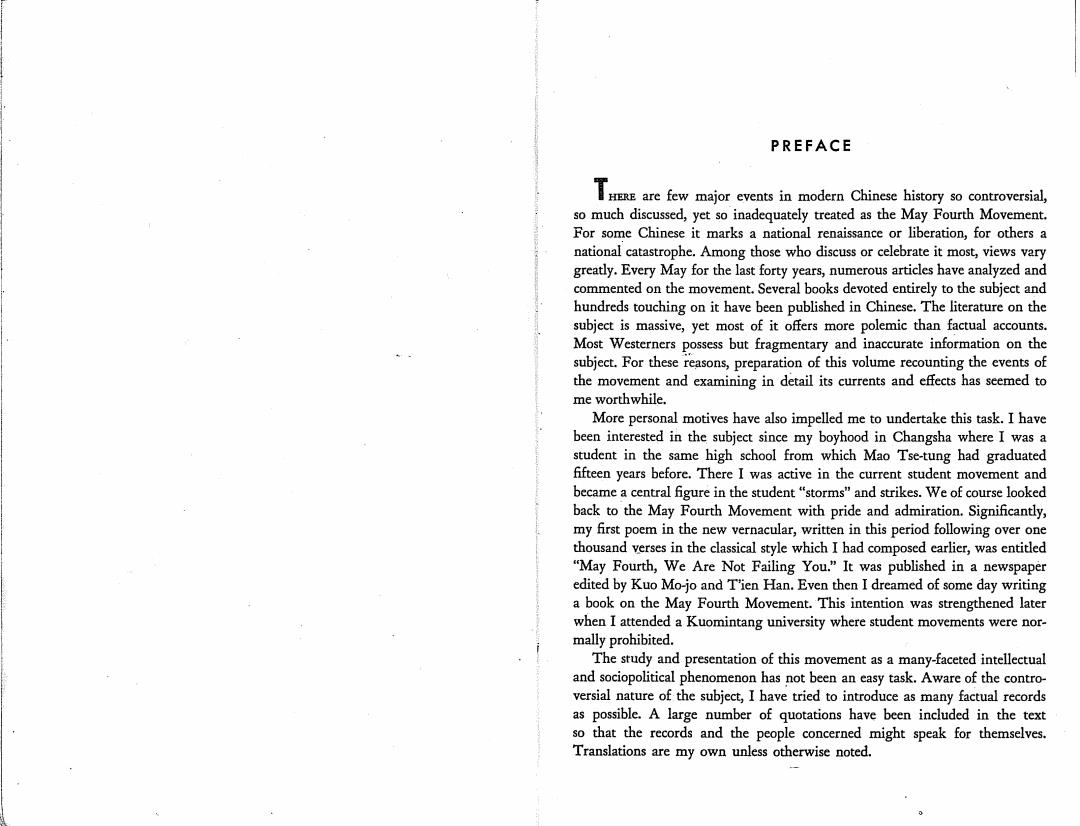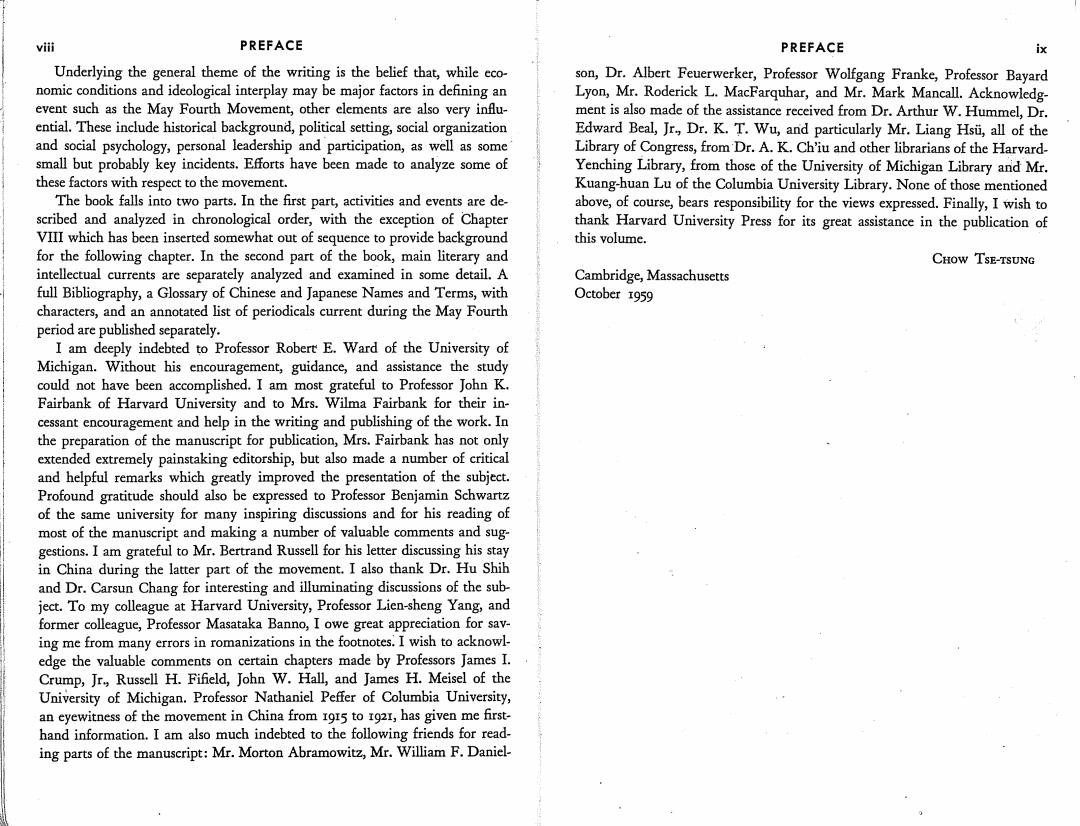
5以.4 6583 C.52m THE MAY FOURTH 五四運動史 MOVEMENT Intellectual Revolution in Modern China Chow Tse-tsung Originally published in the Harvard East Asian Series 中研穿 *1HE0006580 STANFORD UNIVERSITY PRESS Stanford,California

PREFACE refew mjor events in modern Chincse isry so much discussed,yet so inadequately treated as the May Fourth Movement. For some Chinese it marks a national renaissance or liberation,for others a national catastrophe.Among those who discuss or celebrate it most,views vary greatly.Every May for the last forty years,numerous articles have analyzed and commented on the movement.Several books devoted entirely to the subject and hundreds touching on it have been published in Chinese.The literature on the subject is massive,yet most of it offers more polemic than factual accounts. Most Westerners possess but fragmentary and inaccurate information on the subject.For these reasons,preparation of this volume recounting the events of the movement and examining in detail its currents and effects has seemed to me worthwhile. More personal motives have also impelled me to undertake this task.I have been interested in the subject since my boyhood in Changsha where I was a student in the same high school from which Mao Tse-tung had graduated fifteen years before.There I was active in the current student movement and became a central figure in the student"storms"and strikes.We of course looked back to the May Fourth Movement with pride and admiration.Significantly, my first poem in the new vernacular,written in this period following over one thousand verses in the classical style which I had composed earlier,was entitled "May Fourth,We Are Not Failing You."It was published in a newspaper edited by Kuo Mo-jo and T'ien Han.Even then I dreamed of some day writing a book on the May Fourth Movement.This intention was strengthened later when I attended a Kuomintang university where student movements were nor- mally prohibited. The study and presentation of this movement as a many-faceted intellectual and sociopolitical phenomenon has not been an easy task.Aware of the contro- versial nature of the subject,I have tried to introduce as many factual records as possible.A large number of quotations have been included in the text so that the records and the people concerned might speak for themselves. Translations are my own unless otherwise noted

viii PREFACE PREFACE 年 Underlying the general theme of the writing is the belief that,while eco- son,Dr.Albert Feuerwerker,Professor Wolfgang Franke,Professor Bayard nomic conditions and ideological interplay may be major factors in defining an Lyon,Mr.Roderick L.MacFarquhar,and Mr.Mark Mancall.Acknowledg- event such as the May Fourth Movement,other elements are also very influ- ment is also made of the assistance received from Dr.Arthur W.Hummel,Dr. ential.These include historical background,political setting,social organization Edward Beal,Jr,Dr.K.T.Wu,and particularly Mr.Liang Hsi,all of the and social psychology,personal leadership and participation,as well as some Library of Congress,from Dr.A.K.Ch'iu and other librarians of the Harvard- small but probably key incidents.Efforts have been made to analyze some of Yenching Library,from those of the University of Michigan Library and Mr. these factors with respect to the movement. Kuang-huan Lu of the Columbia University Library.None of those mentioned The book falls into two parts.In the first part,activities and events are de- above,of course,bears responsibility for the views expressed.Finally,I wish to scribed and analyzed in chronological order,with the exception of Chapter thank Harvard University Press for its great assistance in the publication of VIII which has been inserted somewhat out of sequence to provide background this volume. for the following chapter.In the second part of the book,main literary and CHOW TSE-TSUNG intellectual currents are separately analyzed and examined in some detail.A Cambridge,Massachusetts full Bibliography,a Glossary of Chinese and Japanese Names and Terms,with October 1959 characters,and an annotated list of periodicals current during the May Fourth period are published separately. I am deeply indebted to Professor Robert E.Ward of the University of Michigan.Without his encouragement,guidance,and assistance the study could not have been accomplished.I am most grateful to Professor John K. Fairbank of Harvard University and to Mrs.Wilma Fairbank for their in- cessant encouragement and help in the writing and publishing of the work.In the preparation of the manuscript for publication,Mrs.Fairbank has not only extended extremely painstaking editorship,but also made a number of critical and helpful remarks which greatly improved the presentation of the subject. Profound gratitude should also be expressed to Professor Benjamin Schwartz of the same university for many inspiring discussions and for his reading of most of the manuscript and making a number of valuable comments and sug- gestions.I am grateful to Mr.Bertrand Russell for his letter discussing his stay in China during the latter part of the movement.I also thank Dr.Hu Shih and Dr.Carsun Chang for interesting and illuminating discussions of the sub- ject.To my colleague at Harvard University,Professor Lien-sheng Yang,and former colleague,Professor Masataka Banno,I owe great appreciation for sav- ing me from many errors in romanizations in the footnotes.I wish to acknowl- edge the valuable comments on certain chapters made by Professors James I. Crump,Jr Russell H.Fifield,John W.Hall,and James H.Meisel of the University of Michigan.Professor Nathaniel Peffer of Columbia University, an eyewitness of the movement in China from I9I5 to Ig21,has given me first. hand information.I am also much indebted to the following friends for read- ing parts of the manuscript:Mr.Morton Abramowitz,Mr.William F.Daniel-

CONTENTS I Introduction Definition of the Movement Economic,Social,and Political Background 6 Significance of the Movement in Historical Perspective II PART ONE DEVELOPMENT OF THE MOVEMENT II Forces that Precipitated the Movement,1915-1918 19 Humiliation of Patriots at Home (Impact of the Twenty-one Demands) Reforming Zeal of Students Abroad 25 I I I The Initial Phase of the Movement:Early Literary and Intellectual Activities,1917-1919 41 Establishment of New Youth Magazine Reforms at Peking University The Alliance of the New Intellectuals and the Establishment of New Tide Magazine Reform Views of the New Intellectuals 58 The Opposition's Argument and the Rejoinder Response of the Youth to the New Ferment 7 The Anti-Japanese Petition of May 19t8 IV The May Fourth Incident y China's Failure at the Versailles Peace Conjerence 4 Chinese Public Sentiment in Respect to the Peace Treaty 8g Disillusioning News from Paris The Students:Their Character and Organization 94 The May Fourth Demonstration From the Legation Quarter to Tsao Julin's House I09 V Developments Following the Incident:Student Demonstrations and Strikes 117 Immediate Reaction of the Government 118 Establishment of the Peking Student Union and Mobilization of the Intellectuals 120 Student Support from Other Cities 129 The President's Disciplinary Mandates and Tsai Yian-p'ei's Departure I3 The Students General Strike 9

xi· CONTENTS CONTENTS ·xi Humanitarianism,Naturalism,and Romanticism:The Society for V I Further Developments:Support from Merchants, Literary Studies and the Creation Society 283 Industrialists,and Workers 145 From Literary Revolution to Revolutionary Literature 287 The Government's Failure to Secure a Compromise from the Students I45 Mass Arrests of June 2,3,and 4 I48 X II The New Thought and Re-evaluation of the Tradition 289 The June Fijth Merchants and Workers Strikes in Shanghai 151 The Hard Core of the Old Thought Settlement of the May Fourth Incident:Fall of the Cabinet and 28g New Thoughts:Realism,Utilitarianism,Liberalism,Individualism, Refusal to Sign the Peace Treaty 158 Socialism,and Darwinism Attempts to Split the Students ajter the Settlement 293 I67 New Methods:Pragmatic,Skeptical,and Agnostic Approaches and the Some Questions Regarding the Settlement I68 Beginning of Marxist Infuence 297 "Down with Confucius and Sons" VII Expansion of the New Culture Movement,1919-1920 171 30o Increasing Unity among the New Intellectuals 71 X I II The New Thought and Later Controversies 314 Invigorated Programs of New Youth and New Tide I74 Doubts on Antiquity Rapid Increase of New Publications and Revamping of Old 176 34 Re-evaluation and Reorganization of the National Heritage 182 37 The Rising Tide of Iconoclasm The Antireligious Movement New Intellectual,Social,and Political Organizations 87 320 Public Education Sponsored by the New Intellectuals The Controversy over Eastern and Western Civilizations I9I 327 Increaring Support for the New Culture Movement The Polemic on Science and Metaphysics I94 V I II Foreign Attitudes Toward the Movement 197 X IV Conclusicn:Various Interpretations and Evaluations 338 A Renaissance,Rsjormaion,or Enlightenment-The Liberals Views The Japanese Reaction 97 8 A Catastrophe to Chisa--Criticisms by the Conservative Nationalists Two Contrasting Western Attitudes:Sympathy and Suspicion 20t and Traditionalists 20g 34 The Soviet Appeal An Anti-Imperialist and Antifeudal Movement Called Forth by Lenin- The Communist Interpretation 347 IX The Ideological and Political Split,1919-1921 215 Who Led the Movement? 355 Major Intellectual Groups Involved in the Split 215 The Real Nature of the Movement-A Suggested Interpretation 358 "Problems and Isms" 2r8 Achievements and Shortcomings Reappraised 36r Sociopolitical Activism versus Cultural Activism 222 Some Further Considerations 366 Democracy,Capitalism,Socialism,and Westernization 228 Participation in Politics 239 A Chronology of Relevant Events,1914-1923 371 X Sociopolitical Consequences,1920-1922 254 Appendixes 379 Reorientation of Political and Economic Organizations 254 A.A Brief Analysis of the Social Forces in the May Fourth Period 379 The Emancipation of Women B.The Number of Schools and Students Involved in the May Fourth Reforms in Education Incident Later Trends in the Student Movement C.Universities and Colleges Involved in the May Fourth Incident 386 D.Data on Workers Strikes in China,1918-1926 3 PART TWO Notes 391 ANALYSIS OF MAIN INTELLECTUAL CURRENTS Index 457 XI The Literary Revolution 269 The Old Literature 26g Advocacy of Realism and the Vernacular in Literary Writing 271 Opposition to the Literary Reform 279